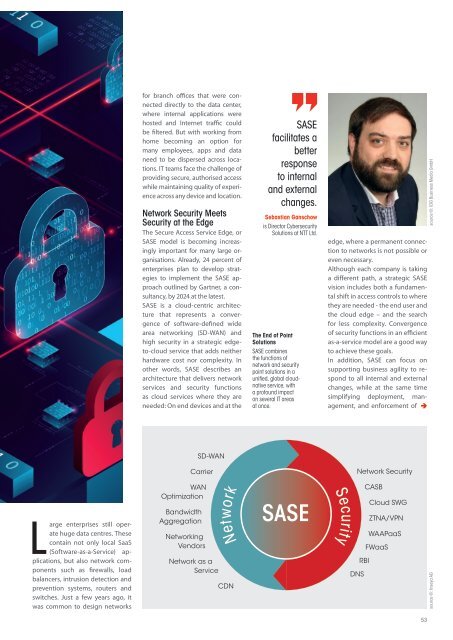Smart Industry No.1 2022
Smart Industry No.1 2022 - The IoT Business Magazine - powered by Avnet Silica
Smart Industry No.1 2022 - The IoT Business Magazine - powered by Avnet Silica
Create successful ePaper yourself
Turn your PDF publications into a flip-book with our unique Google optimized e-Paper software.
for branch offices that were connected<br />
directly to the data center,<br />
where internal applications were<br />
hosted and Internet traffic could<br />
be filtered. But with working from<br />
home becoming an option for<br />
many employees, apps and data<br />
need to be dispersed across locations.<br />
IT teams face the challenge of<br />
providing secure, authorised access<br />
while maintaining quality of experience<br />
across any device and location.<br />
Network Security Meets<br />
Security at the Edge<br />
The Secure Access Service Edge, or<br />
SASE model is becoming increasingly<br />
important for many large organisations.<br />
Already, 24 percent of<br />
enterprises plan to develop strategies<br />
to implement the SASE approach<br />
outlined by Gartner, a consultancy,<br />
by 2024 at the latest.<br />
SASE is a cloud-centric architecture<br />
that represents a convergence<br />
of software-defined wide<br />
area networking (SD-WAN) and<br />
high security in a strategic edgeto-cloud<br />
service that adds neither<br />
hardware cost nor complexity. In<br />
other words, SASE describes an<br />
architecture that delivers network<br />
services and security functions<br />
as cloud services where they are<br />
needed: On end devices and at the<br />
SASE<br />
facilitates a<br />
better<br />
response<br />
to internal<br />
and external<br />
changes.<br />
Sebastian Ganschow<br />
is Director Cybersecurity<br />
Solutions at NTT Ltd.<br />
The End of Point<br />
Solutions<br />
SASE combines<br />
the functions of<br />
network and security<br />
point solutions in a<br />
unified, global cloudnative<br />
service, with<br />
a profound impact<br />
on several IT areas<br />
at once.<br />
edge, where a permanent connection<br />
to networks is not possible or<br />
even necessary.<br />
Although each company is taking<br />
a different path, a strategic SASE<br />
vision includes both a fundamental<br />
shift in access controls to where<br />
they are needed - the end user and<br />
the cloud edge – and the search<br />
for less complexity. Convergence<br />
of security functions in an efficient<br />
as-a-service model are a good way<br />
to achieve these goals.<br />
In addition, SASE can focus on<br />
supporting business agility to respond<br />
to all internal and external<br />
changes, while at the same time<br />
simplifying deployment, management,<br />
and enforcement of<br />
source ©: IDG Business Media GmbH<br />
SD-WAN<br />
Carrier<br />
Network Security<br />
Large enterprises still operate<br />
huge data centres. These<br />
contain not only local SaaS<br />
(Software-as-a-Service) applications,<br />
but also network components<br />
such as firewalls, load<br />
balancers, intrusion detection and<br />
prevention systems, routers and<br />
switches. Just a few years ago, it<br />
was common to design networks<br />
WAN<br />
Optimization<br />
Bandwidth<br />
Aggregation<br />
Networking<br />
Vendors<br />
Network as a<br />
Service<br />
Network<br />
CDN<br />
SASE<br />
Security<br />
DNS<br />
CASB<br />
Cloud SWG<br />
ZTNA/VPN<br />
WAAPaaS<br />
FWaaS<br />
RBI<br />
source ©: Inseya AG<br />
53
















